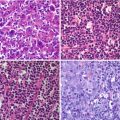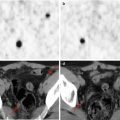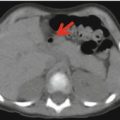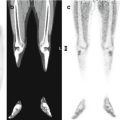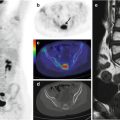Fig. 36.1
Example of PET/CT protocol with 82Rb with attenuation correction CT. PET was carried out with the patient at rest and during adenosine-induced pharmacological stress, with typical timing indications. The post-stress CT can be omitted in modern systems able to realign the rest attenuation correction CT with the stress PET
As there are no published guidelines regarding optimal 82Rb activity in a pediatric population, in most settings activity has been based on the adult recommended activity, scaled according to body weight and depending on the PET acquisition mode: 20–30 MBq/kg for 2-D and 10 MBq/kg for 3-D, with the latter preferred for use in children. In adults, the effective dose for 82Rb was recently recalculated and is now lower than previously estimated, i.e., 1.1 μSv/MBq or 1.5 mSv for a resting + stress study in a 70-kg adult examined using the latest generation 3-D PET/CT scanner [4]. A dedicated dosimetry study should be carried out in the pediatric population in order to more precisely estimate the received radiation dose, but it is certainly ≤2-fold lower than that incurred with MP imaging using the corresponding technetium tracers.
36.3 82Rb Cardiac PET Imaging Protocol
As shown in Fig. 36.1, a very low-dose CT (120 kV, 10 mA) is performed first, for attenuation correction mapping. Then, 82Rb is administered intravenously in a slow bolus over 30 s with the patient at rest. PET acquisition is started simultaneously in list mode for 6–8 min while the ECG gating signal is recorded. After the generator recovery period (10 min), pharmacological stress is started with adenosine (0.84 mg/kg for 6 min) infusion using a dual-channel infusion port (adenosine + 82Rb) under 12-channel ECG monitoring. 82Rb is injected intravenously 2 min after the beginning of adenosine infusion and stress images are acquired again in list mode with ECG gating signals for 6–8 min. A final, very low-dose CT (120 kV, 10 mA) for attenuation correction mapping may be performed, but in most cases the initial rest CT can be used for attenuation correction in modern systems able to realign PET and CT images if significant movements occurred between the two datasets.
PET images are generally reconstructed using ordered subset expectation maximization algorithms (OSEM, 2 iterations, 24 subsets). From the list mode, two datasets are extracted: (1) a series starting 2 min after injection and synchronized with the ECG (8 bins) and (2) a dynamic series (22 frames: 12 × 8, 5 × 12, 1 × 30 s, 1 × 1 and 2× 2 min).
For the analysis, semiquantitative image interpretation is performed using a 17-, 20- or 25-segment model. The summed stress score (SSS) and summed resting score (SRS) can be determined, together with the summed difference score (SDS = SSS − SRS). Both the left ventricular ejection fraction (LVEF) at rest and during stress can also be derived. Finally, flow quantification measurements based on a one-tissue compartment model can be used to estimate the absolute values of myocardial blood flow at rest and during stress as well as the myocardial flow reserve.
36.4 Advantages of PET
Compared to MP imaging by SPECT, 82Rb cardiac PET/CT provides several advantages: (a) shorter acquisition times, (b) better spatial resolution, (c) built-in attenuation correction, (d) lower radiation exposure, and (e) absolute quantitation of MBF, as well as the myocardial flow reserve.
36.5 Clinical Indications
As there are as yet no guidelines for the clinical use of 82Rb MP imaging PET/CT in the pediatric population, potentially useful indications could be as follows: hypertrophic and dilated cardiomyopathies, myocarditis, Kawasaki’s disease, and congenital abnormalities, including single ventricle, Fallot’s tetralogy, anomalous left coronary artery, unique coronary artery, and transposition of the great vessels [5]. Moreover, particularly relevant to the use of MBF quantitation are research topics such as the development of early endothelial dysfunction in early stages of type 1 diabetes in older children and adolescents [6].
Stay updated, free articles. Join our Telegram channel

Full access? Get Clinical Tree


